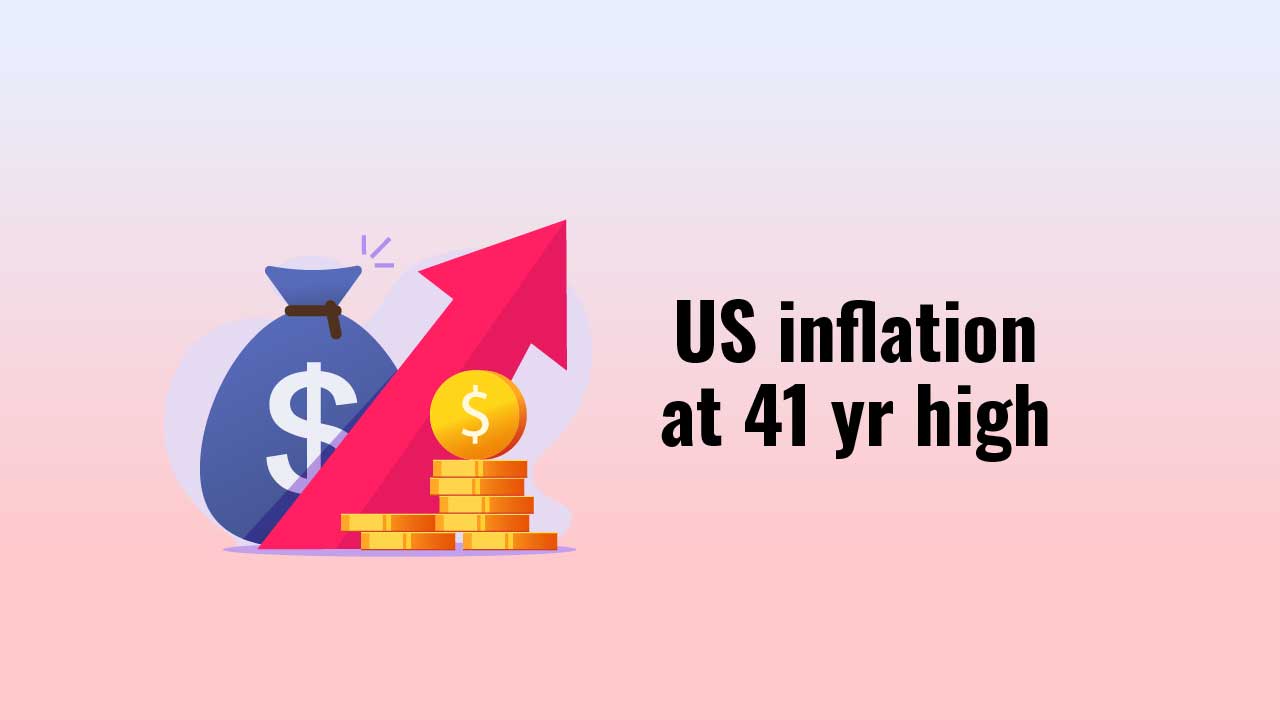US inflation at 41 year high of 8.5% for Mar-22

Last Updated: 13th April 2022 - 03:11 pm
For the month of Mar-22, the all-important US inflation came in at a 41-year high of 8.5%. It was already at 7.5% in Jan-22 and 7.9% in Feb-22. Reuters had projected Mar-22 inflation at 8.4%, but the actual number came in 10 bps higher.
The inflation pressure was most visible in energy which was up 32% YoY but the other 2 important components of food inflation and core inflation were also at elevated levels. This also ratifies Fed’s hawkish stance.
|
Category |
Mar 2022 (YOY) |
Category |
Mar 2022 (YOY) |
|
Food Inflation |
8.80% |
Core Inflation |
6.50% |
|
Food at home |
10.00% |
Commodities less food and energy |
11.70% |
|
Cereals and bakery products |
9.40% |
Apparel |
6.80% |
|
Meats, poultry, fish, and eggs |
13.70% |
New vehicles |
12.50% |
|
Dairy and related products |
7.00% |
Used cars and trucks |
35.30% |
|
Fruits and vegetables |
8.50% |
Medical care commodities |
2.70% |
|
Non-alcoholic beverages |
8.00% |
Alcoholic beverages |
3.70% |
|
Other food at home |
10.30% |
Tobacco and smoking products |
6.9% |
|
Food away from home |
6.90% |
Services less energy services |
4.7% |
|
Full service meals and snacks |
8.00% |
Shelter |
5.0% |
|
Limited service meals and snacks |
7.20% |
Rent of primary residence |
4.4% |
|
Energy Inflation |
32.00% |
Owners’ equivalent rent |
4.5% |
|
Energy commodities |
48.30% |
Medical Care Services |
2.9% |
|
Fuel oil |
70.10% |
Physician Services |
0.7% |
|
Gasoline (all types) |
48.00% |
Hospital Services |
3.3% |
|
Energy services |
13.50% |
Transport Services |
7.7% |
|
Electricity |
11.10% |
Motor vehicle Maintenance |
4.9% |
|
Natural gas (piped) |
21.60% |
Motor vehicle insurance |
4.2% |
|
Headline Consumer Inflation |
8.50% |
Airline Fare |
23.6% |
Data Source: US Bureau of Labour Statistics
Important takeaways from the US inflation data for Mar-22
1) The big driver of US inflation in Mar-22 is energy inflation at 32%, while the other contributors are food inflation at 8.8% and core inflation at 6.5%.
2) The spike in some components is remarkable. Fuel is up 70.1% YoY while gasoline is up 48% YoY. Among other products, airfares are up 23.6%, new vehicles 12.5% and used vehicles 35.3%. High protein foods are up by 13.7% on YoY basis.
3) Even the high frequency inflation (Mar-22 over Feb-22) shows a sharp spike to 1.2%. This compares with 0.8% in Feb-22 and 0.6% in Jan-22. The month-on-month inflation of 1.2% in Mar-22 is the highest in last 13 months.
4) On a sequential basis, energy costs have been the main factor in the spike in consumer inflation. The energy index rose 3.5% in Feb-22 but this sequential growth surged to 11% in Mar-22. That accounts for most of the incremental pressure.
5) The gasoline used in cars surged by 6.6% in Feb-22, but was followed by 18.3% spike in gasoline prices in Mar-22. US gasoline prices are up 48% in last one year and are putting tremendous pressure on an economy where driving is the norm.
6) Crude direct impact is visible but its downstream impact is not easily visible. Due to strong externalities, crude prices manage to seep into cost structure of most products manufactured or services rendered in the US economy. That is the larger risk of oil.
7) The groceries basket is up 1.5% on a sequential basis and 10% on a YoY basis, showing that eating at home is getting expensive. In fact, within the food basket, the spike in the high protein items has been the most acute.
What will the Fed do and what should the RBI do now?
Fed was prepared for 8.5% consumer inflation and it is reflected in the Mar-22 FOMC minutes. Rates were up 25 bps in Mar-22 but could be hiked by 50 bps in May and overall another 200 bps by end of 2022. Fed has made its stand pretty clear.
Come war or famine, the Fed will still only focus on a hawkish policy of raising rates and unwinding the bond book. Of course, unwinding will be gradual at $95 billion of bonds per month from May.
The Indian situation is a bit more complex. India also contends with higher inflation and now it is almost confirmed that Fed will be ultra-hawkish. That means, risk of monetary divergence is huge for the RBI.
Perhaps, RBI can wait till May-22, but if the Fed walks the talk on its monetary hawkishness, then RBI may have limited choice. It will not want to risk monetary divergence, so it may be a rather heavy dose of rate hikes in India too.
- Flat ₹20 Brokerage
- Next-gen Trading
- Advance Charting
- Actionable Ideas
Trending on 5paisa
Disclaimer: Investment in securities market are subject to market risks, read all the related documents carefully before investing. For detailed disclaimer please Click here.
 5paisa Research Team
5paisa Research Team